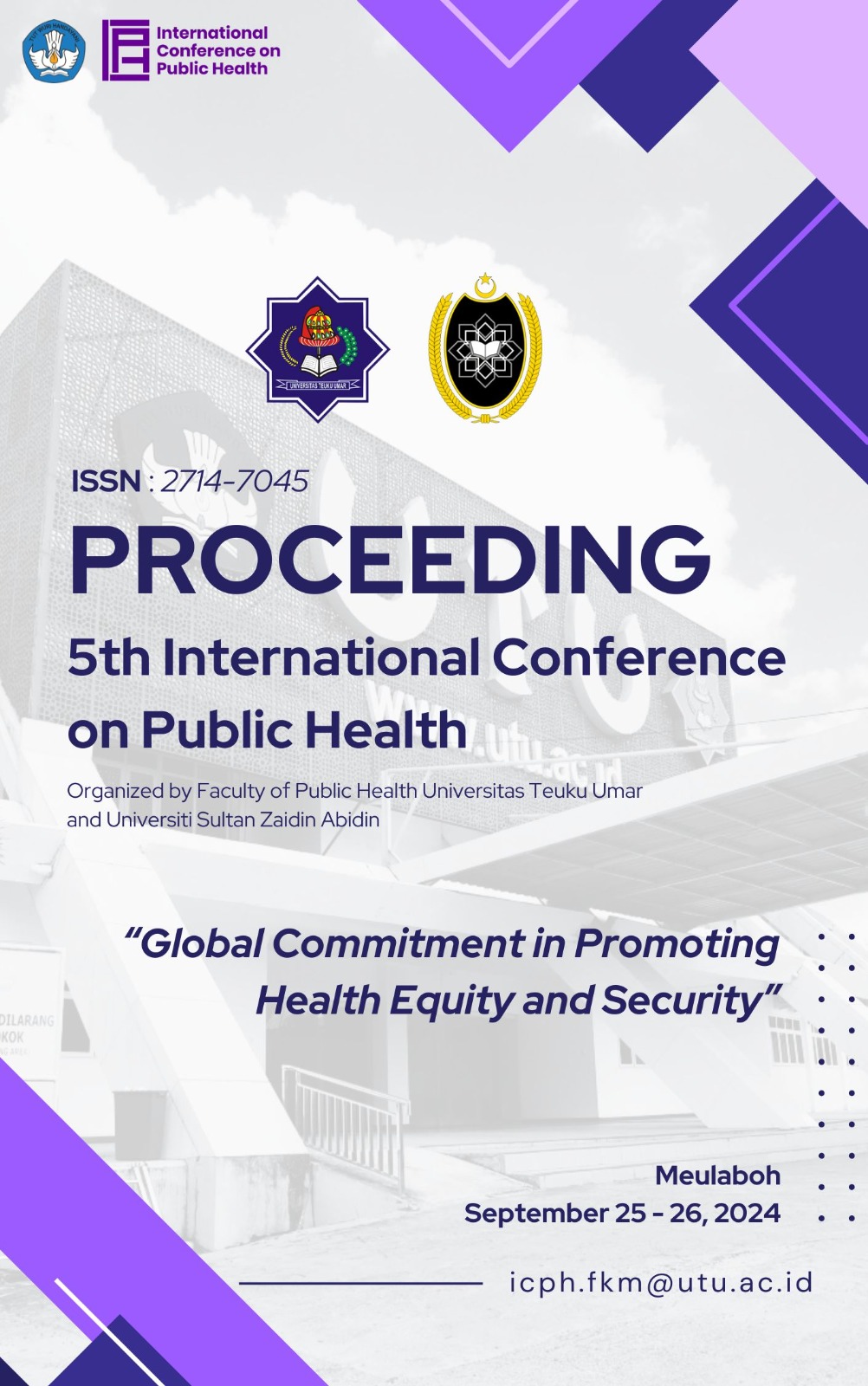First Case Report of Japanese Encephalitis in Boyolali District, Central Java Province, 2023
Keywords:
Boyolali District, First Case, Japanese EncephalitisAbstract
Japanese encephalitis virus is the leading cause of immunization-preventable encephalitis in Asia and the Western Pacific. Most people infected with Japanese Encephalitis have no symptoms or only mild symptoms. However, a small percentage of infected people develop inflammation of the brain (encephalitis), with symptoms including headache, fever, disorientation, seizures, weakness, and coma. This bstract aims to provide an overview of the first case of Japanese Encephalitis in Boyolali District. Reports using descriptive methods based on reports of epidemiologic investigation results. The Case is a 5.5-month-old child with symptoms of fever, seizures, liquid diarrhea, decreased consciousness, and high leukocytes. Treatment was symptomatic. The case and the family had a history of traveling outside the area. From the results of environmental observations, mosquito larvae were found in the bathroom and mosquito breeding sites, such as unused fish ponds, used cans and buckets, piles of clothes, humid house temperatures, and piles of garbage behind the house. Positive results were obtained using the Antibody capture ELISA method based on the IgM Japanese Encephalitis examination. After three times of control in the hospital, on April 13, 2024, the case was declared in good condition. In Boyolali District, Culex mosquitoes at risk of transmitting Japanese encephalitis have been found. With this case, the Boyolali District Health Office conducted education related to Japanese Encephalitis, conducted vector surveys, eradicated mosquito nests, and coordinated with related cross-sectors; if similar cases occurred, they were immediately reported for immediate treatment.
References
Amicizia, D., Zangrillo, F., Lai, P. L., Iovine, M., & Panatto, D. (2018). Overview of Japanese encephalitis disease and its prevention. Focus on IC51 vaccine (IXIARO®). Journal of Preventive Medicine and Hygiene, 59(1), E99–E107.
Chen, Y., Huang, K., Liu, C., & Weng, Y. (2022). Who Is at Risk ? A Critical Case of Japanese Encephalitis. 12(1492), 122–125. https://doi.org/10.6705/j.jacme.202209
Connor, B., & Bunn, W. B. (2017). The changing epidemiology of Japanese encephalitis and New data: The implications for New recommendations for Japanese encephalitis vaccine. Tropical Diseases, Travel Medicine and Vaccines, 3(1), 1–6. https://doi.org/10.1186/s40794-017-0057-x
Garjito, T. A., Widiarti, Anggraeni, Y. M., Alfiah, S., Tunggul Satoto, T. B., Farchanny, A., Samaan, G., Afelt, A., Manguin, S., Frutos, R., & Aditama, T. Y. (2018). Japanese encephalitis in Indonesia: An update on epidemiology and transmission ecology. Acta Tropica, 187, 240–247. https://doi.org/10.1016/j.actatropica.2018.08.017
Heffelfinger, J. D., Li, X., Batmunkh, N., Grabovac, V., Diorditsa, S., Liyanage, J. B., Pattamadilok, S., Bahl, S., Vannice, K. S., Hyde, T. B., Chu, S. Y., Fox, K. K., Hills, S. L., & Marfin, A. A. (2017). Japanese Encephalitis Surveillance and Immunization — Asia and Western Pacific Regions, 2016. MMWR. Morbidity and Mortality Weekly Report, 66(22), 579–583. https://doi.org/10.15585/mmwr.mm6622a3
Ikatan Dokter Anak Indonesia (IDAI). (2018, April 30). Japanese Encephalitis. Retrieved from https://www.idai.or.id/artikel/klinik/imunisasi/japanese-encephalitis
Tamgadge, S., Sakharkar, S., & Umate, R. (2022). Case Report on Nursing Management of Japanese Encephalitis with Convulsion. Journal of Pharmaceutical Negative Results, 13(3), 906–908. https://doi.org/10.47750/pnr.2022.13.03.135
Kasarla, R. R., Sudi, R., & Pathak, L. (n.d.). ABSTRACT. 12(01).
Kosen, S., Khoe, L. C., Indriasih, E., Tarigan, I., Iriawan, R. W., Agustiya, R. I., Letson, G. W., & Vodicka, E. (2022). Expanding japanese encephalitis vaccination to selected endemic indonesia provinces: A cost-effectiveness analysis. Vaccine: X, 11, 100179. https://doi.org/10.1016/j.jvacx.2022.100179
Liu, B. (2018). Influence of Host and Environmental Factors on the Distribution of the Japanese Encephalitis Vector Culex tritaeniorhynchus in China. https://doi.org/10.3390/ijerph15091848
Mapangdol,S.,Justin R., Zheila M., Blanco, C., Andrada, S., Pamintuan R., Magpantay, R &Lonogand, K. (2024). A case report of Japanese encephalitis in Paracelis, Mountain Province, the Philippines. 15(2), 1–6. https://doi.org/10.5365/wpsar.2024.15.2.1049
Quan, T. M., Thao, T. T. N., Duy, N. M., Nhat, T. M., & Clapham, H. E. (2020). Estimates of the global burden of japanese encephalitis and the impact of vaccination from 2000-2015. ELife, 9, 1–187. https://doi.org/10.7554/eLife.51027
Rahmayanti, A., Pinontoan, O., Sondakh, R., Kesehatan, F., Universitas, M., Ratulangi, S., Vishnui, C., Gelidus, C., Tritaeniorhynchus, C., & Quinquefasciatus, C. (2017). Survei Dan Pemetaan Nyamuk Culex Spp Di Kecamatan Malalayang Kota Manado Sulawesi Utara. Kesmas, 6(3), 1–8.
Report, C. (2024). A case report of Japanese encephalitis in Paracelis, Mountain Province, the Philippines. 15(2), 1–6. https://doi.org/10.5365/wpsar.2024.15.2.1049
Sewgobind, S., Johnson, N., & Mansfield, K. L. (2022). JMM Profile : Japanese encephalitis virus : an emerging threat. 1–6. https://doi.org/10.1099/jmm.0.001620
Sunwoo, J., Lee, S., Jung, K., Park, K., Moon, J., Jung, K., Kim, M., Lee, S. K., & Chu, K. (2017). Clinical Characteristics of Severe Japanese Encephalitis : A Case Series from South Korea. 97(2), 369–375. https://doi.org/10.4269/ajtmh.17-0054
Tamgadge, S., Sakharkar, S., & Umate, R. (2022). Case Report on Nursing Management of Japanese Encephalitis with Convulsion. Journal of Pharmaceutical Negative Results, 13(3), 906–908. https://doi.org/10.47750/pnr.2022.13.03.135
Vannice, K. S., Hills, S. L., Schwartz, L. M., Barrett, A. D., Heffel, J., Hombach, J., Letson, G. W., Solomon, T., & Mar, A. A. (2021). The future of Japanese encephalitis vaccination : expert recommendations for achieving and maintaining optimal JE control. 1–9. https://doi.org/10.1038/s41541-021-00338-z





